Improving performance of the asynchronous cooperative relay network with maximum ratio combining and transmit antenna selection technique
In this paper, a new amplify and forward (AF) asynchronous cooperative relay network using maximum
ratio combining (MRC) and transmit antenna selection (TAS) technique is considered. In order to obtain a
maximal received diversity gain, the received signal vectors from all antennas of the each relay node are jointly
combined by MRC technique in the first phase. Then, one antenna of each relay node is selected for forwarding
MRC signal vectors to the destination node in the second phase. The proposed scheme not only offers to reduce
the interference components induced by inter-symbol interference (ISI) among the relay nodes, but also can
effectively remove them with employment near-optimum detection (NOD) at the destination node as compared
to the previous distributed close loop extended-orthogonal space time block code (DCL EO-STBC) scheme. The
analysis and simulation results confirm that the new scheme outperforms the previous cooperative relay
networks in both synchronous and asynchronous conditions. Moreover, the proposed scheme allows to reduce
the requirement of the Radio-Frequency (RF) chains at the relay nodes and is extended to general multi-antenna
relay network without decreasing transmission rate.
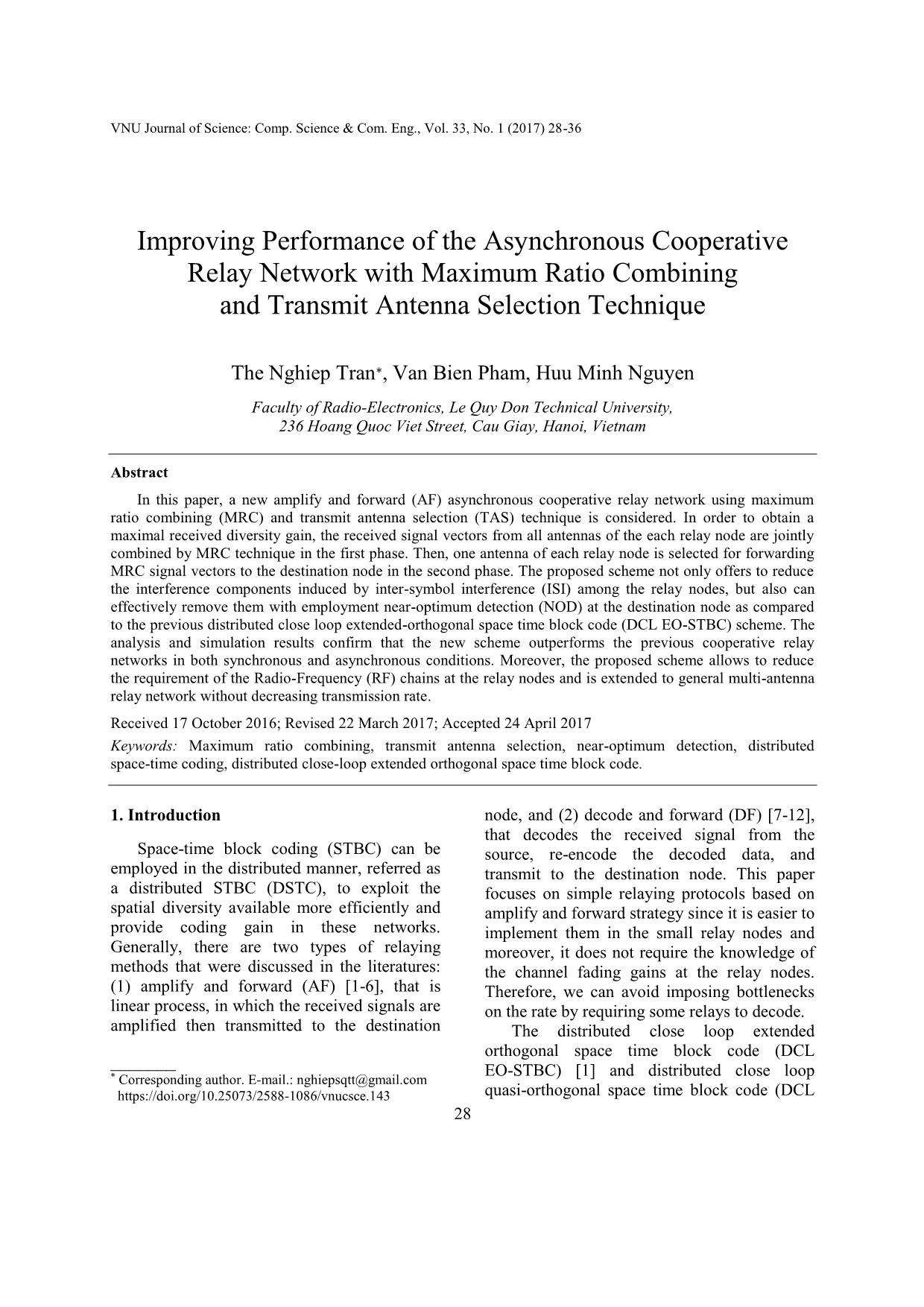
Trang 1
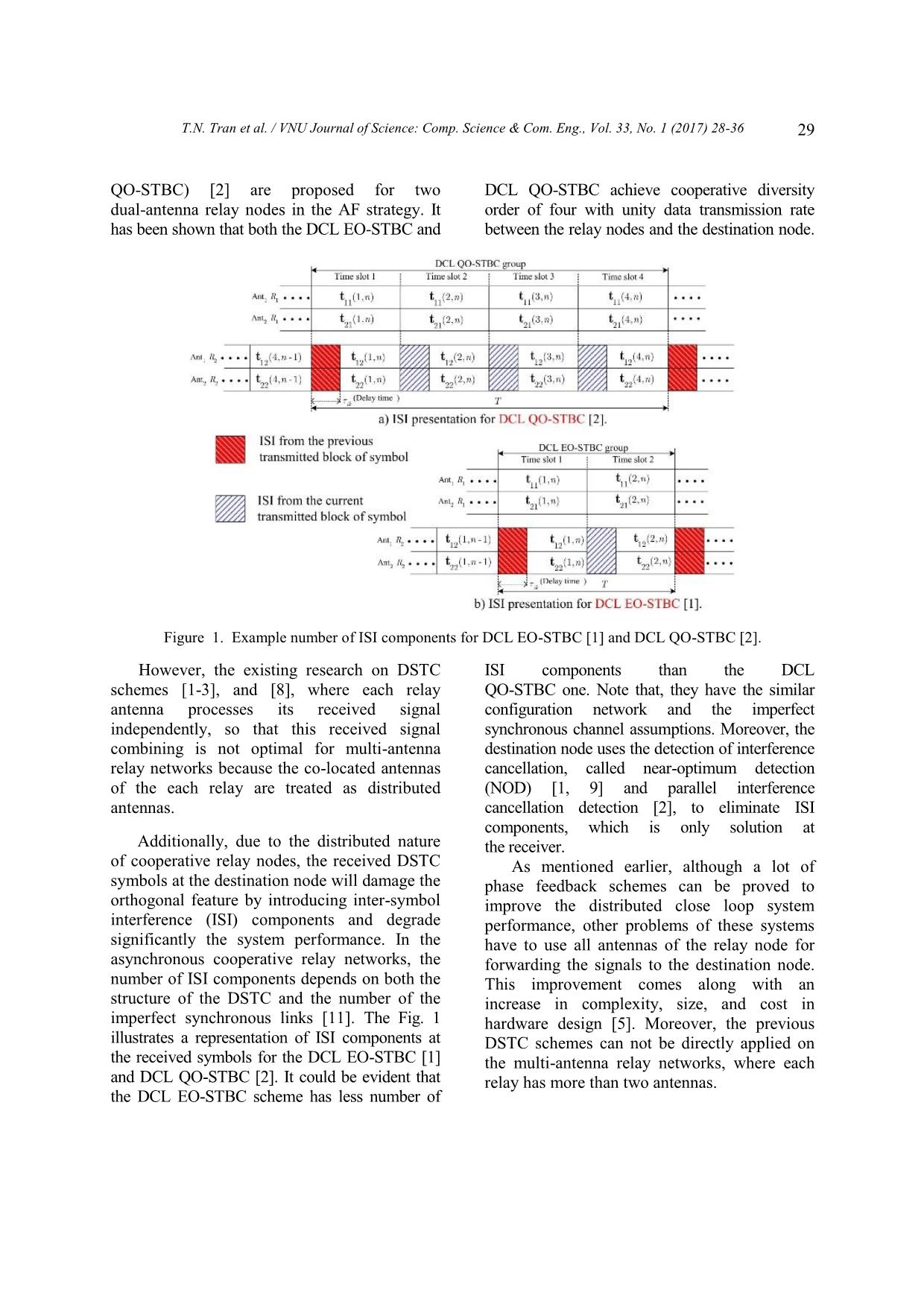
Trang 2
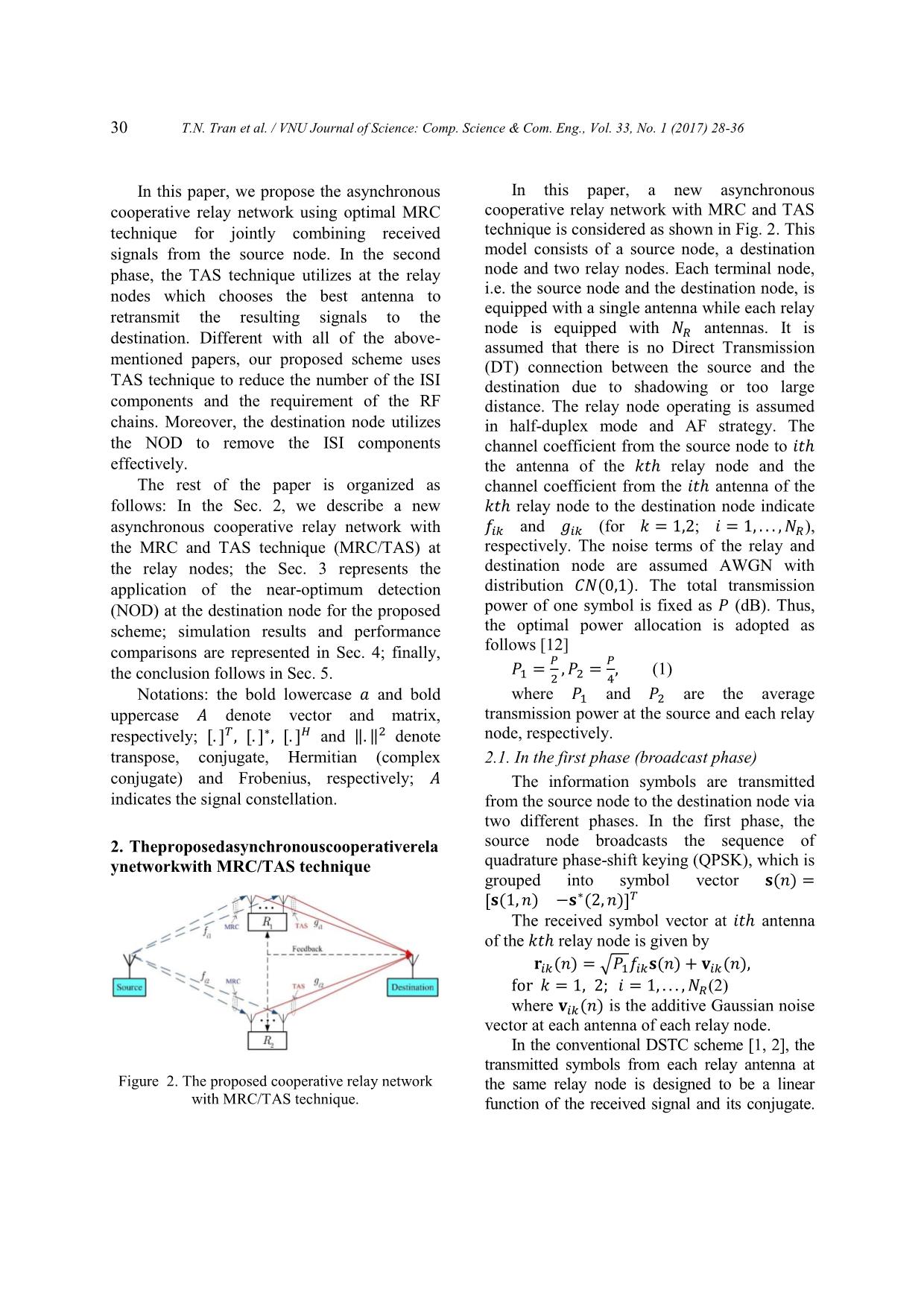
Trang 3
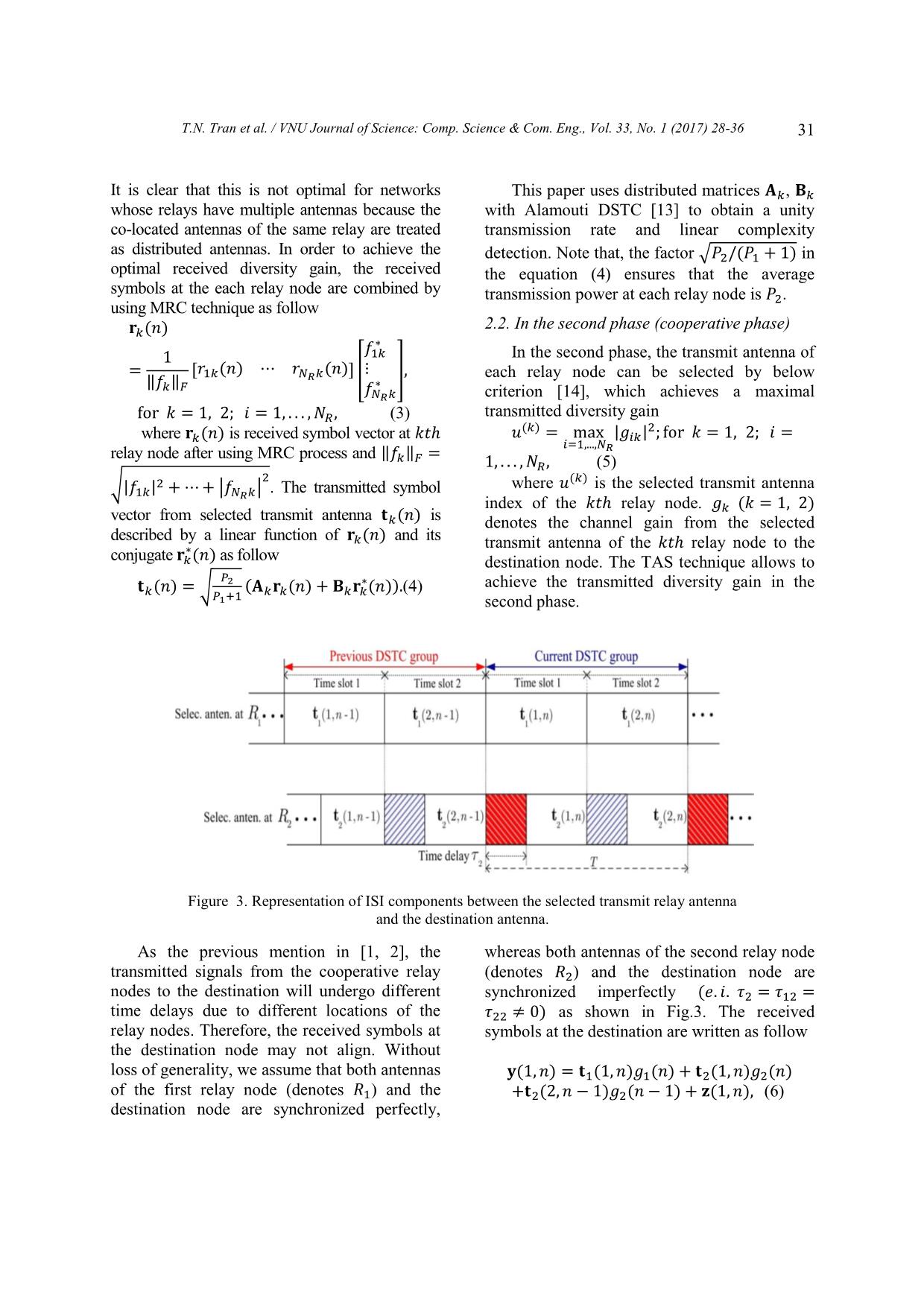
Trang 4
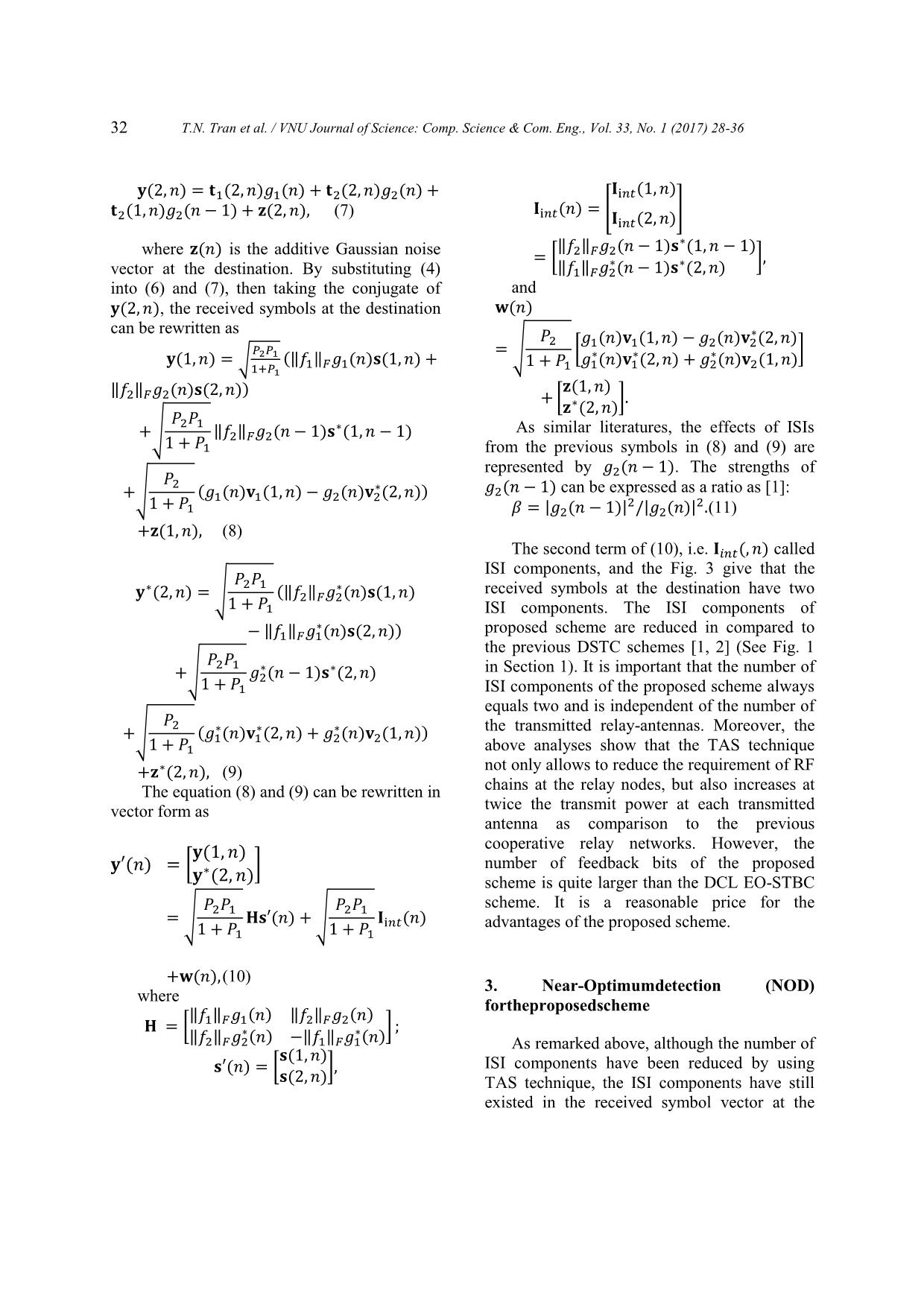
Trang 5
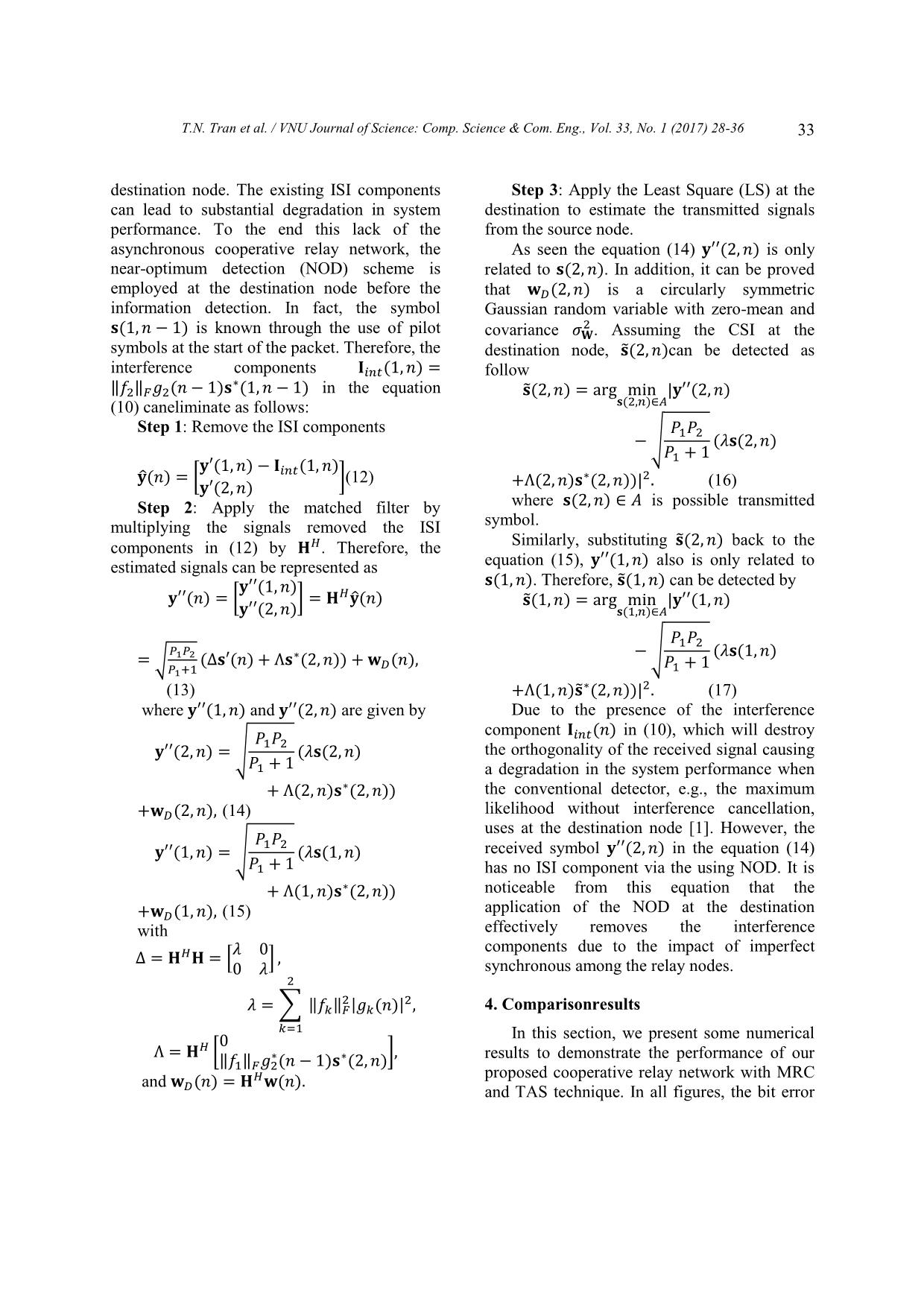
Trang 6
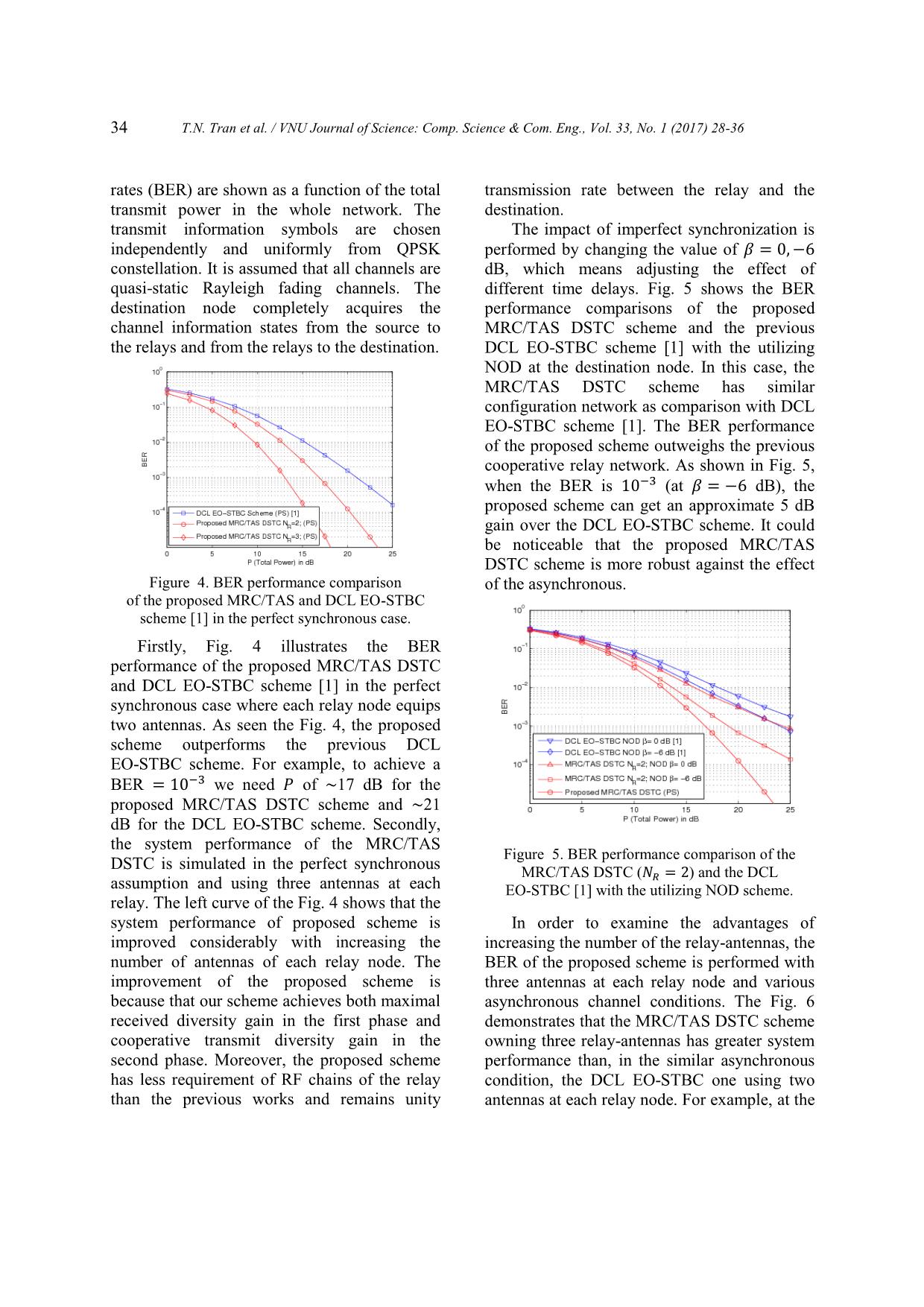
Trang 7
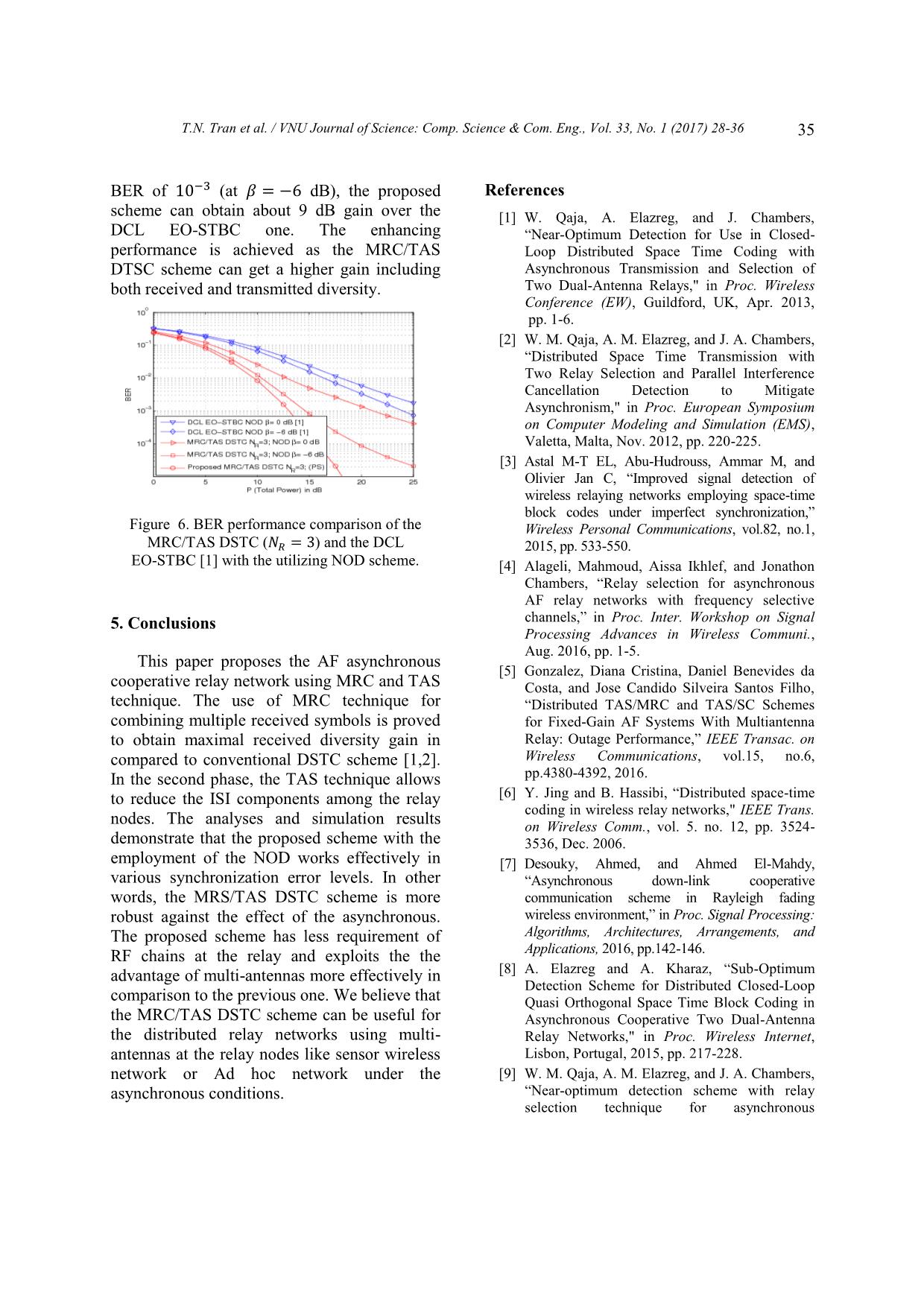
Trang 8
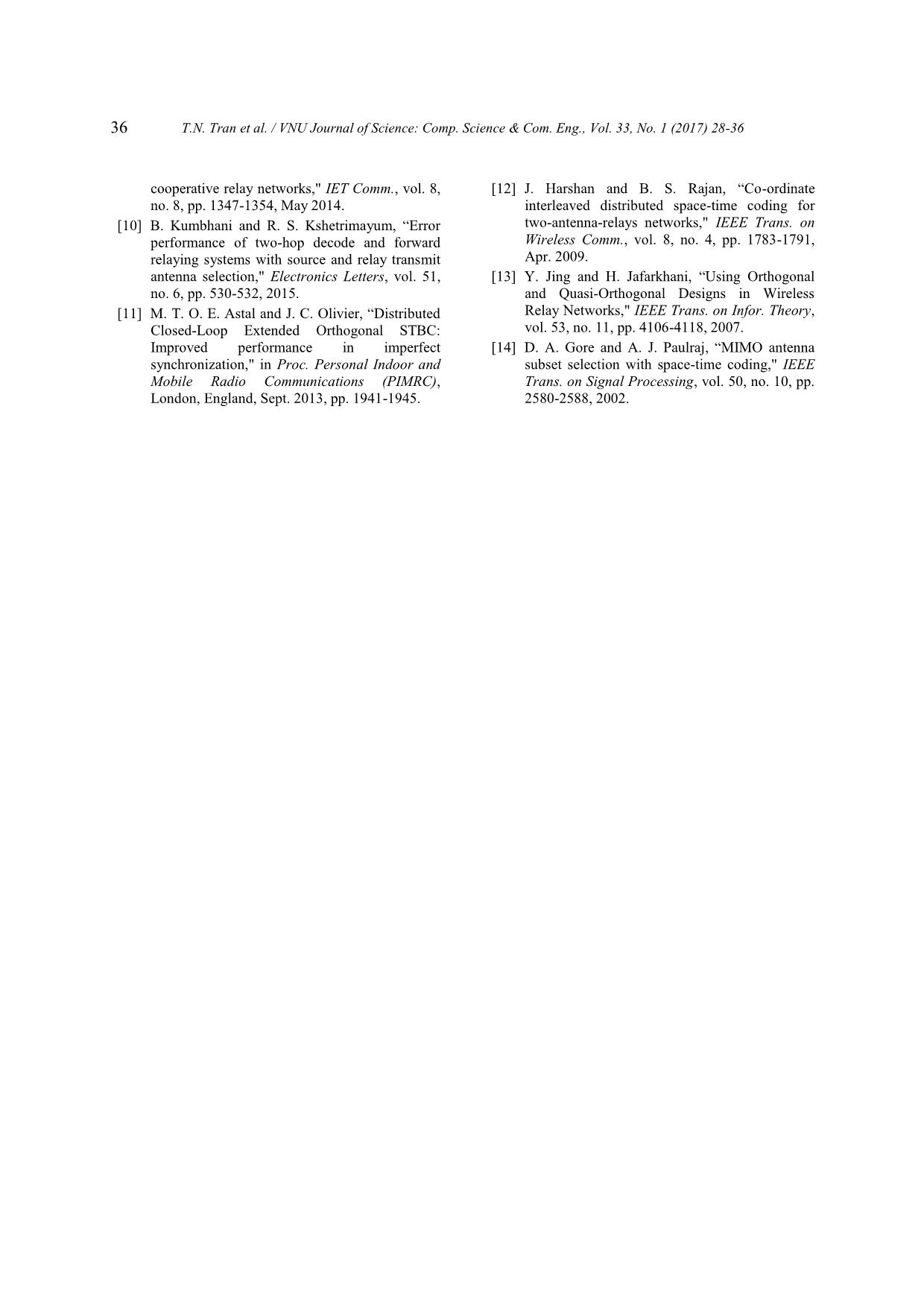
Trang 9
Tóm tắt nội dung tài liệu: Improving performance of the asynchronous cooperative relay network with maximum ratio combining and transmit antenna selection technique
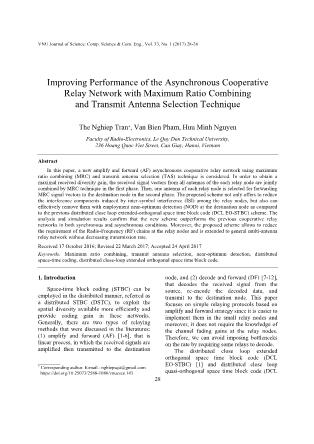
ntenna 퐭 (푛) is denotes the channel gain from the selected described by a linear function of 퐫 (푛) and its ∗ transmit antenna of the 푡ℎ relay node to the conjugate 퐫 (푛) as follow destination node. The TAS technique allows to 푃2 ∗ achieve the transmitted diversity gain in the 퐭 (푛) = √ (퐀 퐫 (푛) + 퐁 퐫 (푛)).(4) 푃1+1 second phase. G Figure 3. Representation of ISI components between the selected transmit relay antenna and the destination antenna. As the previous mention in [1, 2], the whereas both antennas of the second relay node transmitted signals from the cooperative relay (denotes 푅2) and the destination node are nodes to the destination will undergo different synchronized imperfectly (푒. 𝑖. 휏2 = 휏12 = time delays due to different locations of the 휏22 ≠ 0) as shown in Fig.3. The received relay nodes. Therefore, the received symbols at symbols at the destination are written as follow the destination node may not align. Without loss of generality, we assume that both antennas 퐲(1, 푛) = 퐭1(1, 푛) 1(푛) + 퐭2(1, 푛) 2(푛) of the first relay node (denotes 푅1) and the +퐭2(2, 푛 − 1) 2(푛 − 1) + 퐳(1, 푛), (6) destination node are synchronized perfectly, 32 T.N. Tran et al. / VNU Journal of Science: Comp. Science & Com. Eng., Vol. 33, No. 1 (2017) 28-36 퐲(2, 푛) = 퐭1(2, 푛) 1(푛) + 퐭2(2, 푛) 2(푛) + 퐈i푛푡(1, 푛) 퐭2(1, 푛) 2(푛 − 1) + 퐳(2, 푛), (7) 퐈i푛푡(푛) = [ ] 퐈i푛푡(2, 푛) ∗ where 퐳(푛) is the additive Gaussian noise ‖ 2‖퐹 2(푛 − 1)퐬 (1, 푛 − 1) = [ ∗ ∗ ], vector at the destination. By substituting (4) ‖ 1‖퐹 2(푛 − 1)퐬 (2, 푛) into (6) and (7), then taking the conjugate of and 퐲(2, 푛), the received symbols at the destination 퐰(푛) can be rewritten as ∗ 푃2 1(푛)퐯1(1, 푛) − 2(푛)퐯2(2, 푛) 푃2푃1 = √ [ ∗ ∗ ∗ ] 퐲(1, 푛) = √ (‖ 1‖퐹 1(푛)퐬(1, 푛) + 1 + 푃1 1(푛)퐯1(2, 푛) + 2(푛)퐯2(1, 푛) 1+푃1 ‖ ‖ ) 퐳(1, 푛) 2 퐹 2(푛)퐬(2, 푛) + [ ]. 퐳∗(2, 푛) 푃 푃 2 1 ∗ As similar literatures, the effects of ISIs +√ ‖ 2‖퐹 2(푛 − 1)퐬 (1, 푛 − 1) 1 + 푃1 from the previous symbols in (8) and (9) are represented by 2(푛 − 1). The strengths of 푃2 +√ ( (푛)퐯 (1, 푛) − (푛)퐯∗(2, 푛)) 2(푛 − 1) can be expressed as a ratio as [1]: 1 + 푃 1 1 2 2 2 2 1 훽 = | 2(푛 − 1)| /| 2(푛)| . (11) +퐳(1, 푛), (8) The second term of (10), i.e. 퐈푖푛푡(, 푛) called ISI components, and the Fig. 3 give that the 푃 푃 ∗ 2 1 ∗ received symbols at the destination have two 퐲 (2, 푛) = √ (‖ 2‖퐹 2(푛)퐬(1, 푛) 1 + 푃1 ISI components. The ISI components of ∗ proposed scheme are reduced in compared to − ‖ 1‖퐹 1(푛)퐬(2, 푛)) the previous DSTC schemes [1, 2] (See Fig. 1 푃2푃1 ∗ ∗ in Section 1). It is important that the number of +√ 2(푛 − 1)퐬 (2, 푛) 1 + 푃1 ISI components of the proposed scheme always equals two and is independent of the number of 푃2 ∗ ∗ ∗ the transmitted relay-antennas. Moreover, the +√ ( 1(푛)퐯1(2, 푛) + 2(푛)퐯2(1, 푛)) 1 + 푃1 above analyses show that the TAS technique +퐳∗(2, 푛), (9) not only allows to reduce the requirement of RF The equation (8) and (9) can be rewritten in chains at the relay nodes, but also increases at vector form as twice the transmit power at each transmitted antenna as comparison to the previous 퐲(1, 푛) cooperative relay networks. However, the 퐲′(푛) = [ ∗ ] number of feedback bits of the proposed 퐲 (2, 푛) scheme is quite larger than the DCL EO-STBC 푃2푃1 푃2푃1 scheme. It is a reasonable price for the = √ 퐇퐬′(푛) + √ 퐈i푛푡(푛) advantages of the proposed scheme. 1 + 푃1 1 + 푃1 +퐰(푛), (10) 3. Near-Optimumdetection (NOD) where fortheproposedscheme ‖ 1‖퐹 1(푛) ‖ 2‖퐹 2(푛) 퐇 = [ ∗ ∗ ] ; ‖ 2‖퐹 2(푛) −‖ 1‖퐹 1(푛) As remarked above, although the number of 퐬(1, 푛) 퐬′(푛) = [ ], ISI components have been reduced by using 퐬(2, 푛) TAS technique, the ISI components have still existed in the received symbol vector at the T.N. Tran et al. / VNU Journal of Science: Comp. Science & Com. Eng., Vol. 33, No. 1 (2017) 28-36 33 destination node. The existing ISI components Step 3: Apply the Least Square (LS) at the can lead to substantial degradation in system destination to estimate the transmitted signals performance. To the end this lack of the from the source node. asynchronous cooperative relay network, the As seen the equation (14) 퐲′′(2, 푛) is only near-optimum detection (NOD) scheme is related to 퐬(2, 푛). In addition, it can be proved employed at the destination node before the that 퐰 (2, 푛) is a circularly symmetric information detection. In fact, the symbol Gaussian random variable with zero-mean and 2 퐬(1, 푛 − 1) is known through the use of pilot covariance 휎퐖. Assuming the CSI at the symbols at the start of the packet. Therefore, the destination node, 퐬̃(2, 푛)can be detected as interference components 퐈푖푛푡(1, 푛) = follow ∗ ‖ 2‖퐹 2(푛 − 1)퐬 (1, 푛 − 1) in the equation 퐬̃(2, 푛) = arg min |퐲′′(2, 푛) (10) caneliminate as follows: 퐬(2,푛)∈ Step 1: Remove the ISI components 푃1푃2 − √ (휆퐬(2, 푛) 푃1 + 1 퐲′(1, 푛) − 퐈 (1, 푛) 퐲̂(푛) = [ 푖푛푡 ](12) ∗ 2 퐲′(2, 푛) +Λ(2, 푛)퐬 (2, 푛))| . (16) Step 2: Apply the matched filter by where 퐬(2, 푛) ∈ is possible transmitted multiplying the signals removed the ISI symbol. components in (12) by 퐇 . Therefore, the Similarly, substituting 퐬̃(2, 푛) back to the estimated signals can be represented as equation (15), 퐲′′(1, 푛) also is only related to 퐲′′(1, 푛) 퐬(1, 푛). Therefore, 퐬̃(1, 푛) can be detected by 퐲′′(푛) = [ ] = 퐇 퐲̂(푛) 퐬̃(1, 푛) = arg min |퐲′′(1, 푛) 퐲′′(2, 푛) 퐬(1,푛)∈ 푃1푃2 푃1푃2 ∗ − √ (휆퐬(1, 푛) = √ (Δ퐬′(푛) + Λ퐬 (2, 푛)) + 퐰 (푛), 푃 + 1 푃1+1 1 (13) +Λ(1, 푛)퐬̃∗(2, 푛))|2. (17) where 퐲′′(1, 푛) and 퐲′′(2, 푛) are given by Due to the presence of the interference component 퐈 (푛) in (10), which will destroy 푃 푃 푖푛푡 퐲′′(2, 푛) = √ 1 2 (휆퐬(2, 푛) the orthogonality of the received signal causing 푃1 + 1 a degradation in the system performance when + Λ(2, 푛)퐬∗(2, 푛)) the conventional detector, e.g., the maximum +퐰 (2, 푛), (14) likelihood without interference cancellation, uses at the destination node [1]. However, the 푃 푃 퐲′′(1, 푛) = √ 1 2 (휆퐬(1, 푛) received symbol 퐲′′(2, 푛) in the equation (14) 푃1 + 1 has no ISI component via the using NOD. It is + Λ(1, 푛)퐬∗(2, 푛)) noticeable from this equation that the application of the NOD at the destination +퐰 (1, 푛), (15) with effectively removes the interference 휆 0 components due to the impact of imperfect Δ = 퐇 퐇 = [ ] , 0 휆 synchronous among the relay nodes. 2 2 2 휆 = ∑ ‖ ‖퐹| (푛)| , 4. Comparisonresults =1 0 In this section, we present some numerical Λ = 퐇 [ ], ‖ ‖ ∗(푛 − 1)퐬∗(2, 푛) results to demonstrate the performance of our 1 퐹 2 proposed cooperative relay network with MRC and 퐰 (푛) = 퐇 퐰(푛). and TAS technique. In all figures, the bit error 34 T.N. Tran et al. / VNU Journal of Science: Comp. Science & Com. Eng., Vol. 33, No. 1 (2017) 28-36 rates (BER) are shown as a function of the total transmission rate between the relay and the transmit power in the whole network. The destination. transmit information symbols are chosen The impact of imperfect synchronization is independently and uniformly from QPSK performed by changing the value of 훽 = 0, −6 constellation. It is assumed that all channels are dB, which means adjusting the effect of quasi-static Rayleigh fading channels. The different time delays. Fig. 5 shows the BER destination node completely acquires the performance comparisons of the proposed channel information states from the source to MRC/TAS DSTC scheme and the previous the relays and from the relays to the destination. DCL EO-STBC scheme [1] with the utilizing NOD at the destination node. In this case, the MRC/TAS DSTC scheme has similar configuration network as comparison with DCL EO-STBC scheme [1]. The BER performance of the proposed scheme outweighs the previous cooperative relay network. As shown in Fig. 5, when the BER is 10−3 (at 훽 = −6 dB), the proposed scheme can get an approximate 5 dB gain over the DCL EO-STBC scheme. It could be noticeable that the proposed MRC/TAS DSTC scheme is more robust against the effect Figure 4. BER performance comparison of the asynchronous. of the proposed MRC/TAS and DCL EO-STBC scheme [1] in the perfect synchronous case. Firstly, Fig. 4 illustrates the BER performance of the proposed MRC/TAS DSTC and DCL EO-STBC scheme [1] in the perfect synchronous case where each relay node equips two antennas. As seen the Fig. 4, the proposed scheme outperforms the previous DCL EO-STBC scheme. For example, to achieve a BER = 10−3 we need 푃 of ~17 dB for the proposed MRC/TAS DSTC scheme and ~21 dB for the DCL EO-STBC scheme. Secondly, the system performance of the MRC/TAS Figure 5. BER performance comparison of the DSTC is simulated in the perfect synchronous MRC/TAS DSTC ( 푅 = 2) and the DCL assumption and using three antennas at each EO-STBC [1] with the utilizing NOD scheme. relay. The left curve of the Fig. 4 shows that the system performance of proposed scheme is In order to examine the advantages of improved considerably with increasing the increasing the number of the relay-antennas, the number of antennas of each relay node. The BER of the proposed scheme is performed with improvement of the proposed scheme is three antennas at each relay node and various because that our scheme achieves both maximal asynchronous channel conditions. The Fig. 6 received diversity gain in the first phase and demonstrates that the MRC/TAS DSTC scheme cooperative transmit diversity gain in the owning three relay-antennas has greater system second phase. Moreover, the proposed scheme performance than, in the similar asynchronous has less requirement of RF chains of the relay condition, the DCL EO-STBC one using two than the previous works and remains unity antennas at each relay node. For example, at the T.N. Tran et al. / VNU Journal of Science: Comp. Science & Com. Eng., Vol. 33, No. 1 (2017) 28-36 35 BER of 10−3 (at 훽 = −6 dB), the proposed References scheme can obtain about 9 dB gain over the [1] W. Qaja, A. Elazreg, and J. Chambers, DCL EO-STBC one. The enhancing “Near-Optimum Detection for Use in Closed- performance is achieved as the MRC/TAS Loop Distributed Space Time Coding with DTSC scheme can get a higher gain including Asynchronous Transmission and Selection of both received and transmitted diversity. Two Dual-Antenna Relays," in Proc. Wireless Conference (EW), Guildford, UK, Apr. 2013, pp. 1-6. [2] W. M. Qaja, A. M. Elazreg, and J. A. Chambers, “Distributed Space Time Transmission with Two Relay Selection and Parallel Interference Cancellation Detection to Mitigate Asynchronism," in Proc. European Symposium on Computer Modeling and Simulation (EMS), Valetta, Malta, Nov. 2012, pp. 220-225. [3] Astal M-T EL, Abu-Hudrouss, Ammar M, and Olivier Jan C, “Improved signal detection of wireless relaying networks employing space-time block codes under imperfect synchronization,” Figure 6. BER performance comparison of the Wireless Personal Communications, vol.82, no.1, MRC/TAS DSTC ( 푅 = 3) and the DCL 2015, pp. 533-550. EO-STBC [1] with the utilizing NOD scheme. [4] Alageli, Mahmoud, Aissa Ikhlef, and Jonathon Chambers, “Relay selection for asynchronous AF relay networks with frequency selective 5. Conclusions channels,” in Proc. Inter. Workshop on Signal Processing Advances in Wireless Communi., Aug. 2016, pp. 1-5. This paper proposes the AF asynchronous [5] Gonzalez, Diana Cristina, Daniel Benevides da cooperative relay network using MRC and TAS Costa, and Jose Candido Silveira Santos Filho, technique. The use of MRC technique for “Distributed TAS/MRC and TAS/SC Schemes combining multiple received symbols is proved for Fixed-Gain AF Systems With Multiantenna to obtain maximal received diversity gain in Relay: Outage Performance,” IEEE Transac. on compared to conventional DSTC scheme [1,2]. Wireless Communications, vol.15, no.6, In the second phase, the TAS technique allows pp.4380-4392, 2016. to reduce the ISI components among the relay [6] Y. Jing and B. Hassibi, “Distributed space-time coding in wireless relay networks," IEEE Trans. nodes. The analyses and simulation results on Wireless Comm., vol. 5. no. 12, pp. 3524- demonstrate that the proposed scheme with the 3536, Dec. 2006. employment of the NOD works effectively in [7] Desouky, Ahmed, and Ahmed El-Mahdy, various synchronization error levels. In other “Asynchronous down-link cooperative words, the MRS/TAS DSTC scheme is more communication scheme in Rayleigh fading robust against the effect of the asynchronous. wireless environment,” in Proc. Signal Processing: The proposed scheme has less requirement of Algorithms, Architectures, Arrangements, and RF chains at the relay and exploits the the Applications, 2016, pp.142-146. advantage of multi-antennas more effectively in [8] A. Elazreg and A. Kharaz, “Sub-Optimum Detection Scheme for Distributed Closed-Loop comparison to the previous one. We believe that Quasi Orthogonal Space Time Block Coding in the MRC/TAS DSTC scheme can be useful for Asynchronous Cooperative Two Dual-Antenna the distributed relay networks using multi- Relay Networks," in Proc. Wireless Internet, antennas at the relay nodes like sensor wireless Lisbon, Portugal, 2015, pp. 217-228. network or Ad hoc network under the [9] W. M. Qaja, A. M. Elazreg, and J. A. Chambers, asynchronous conditions. “Near-optimum detection scheme with relay selection technique for asynchronous 36 T.N. Tran et al. / VNU Journal of Science: Comp. Science & Com. Eng., Vol. 33, No. 1 (2017) 28-36 cooperative relay networks," IET Comm., vol. 8, [12] J. Harshan and B. S. Rajan, “Co-ordinate no. 8, pp. 1347-1354, May 2014. interleaved distributed space-time coding for [10] B. Kumbhani and R. S. Kshetrimayum, “Error two-antenna-relays networks," IEEE Trans. on performance of two-hop decode and forward Wireless Comm., vol. 8, no. 4, pp. 1783-1791, relaying systems with source and relay transmit Apr. 2009. antenna selection," Electronics Letters, vol. 51, [13] Y. Jing and H. Jafarkhani, “Using Orthogonal no. 6, pp. 530-532, 2015. and Quasi-Orthogonal Designs in Wireless [11] M. T. O. E. Astal and J. C. Olivier, “Distributed Relay Networks," IEEE Trans. on Infor. Theory, Closed-Loop Extended Orthogonal STBC: vol. 53, no. 11, pp. 4106-4118, 2007. Improved performance in imperfect [14] D. A. Gore and A. J. Paulraj, “MIMO antenna synchronization," in Proc. Personal Indoor and subset selection with space-time coding," IEEE Mobile Radio Communications (PIMRC), Trans. on Signal Processing, vol. 50, no. 10, pp. London, England, Sept. 2013, pp. 1941-1945. 2580-2588, 2002. G h
File đính kèm:
 improving_performance_of_the_asynchronous_cooperative_relay.pdf
improving_performance_of_the_asynchronous_cooperative_relay.pdf

